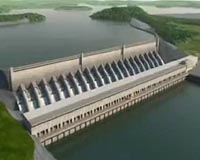| . |  |
. |
Dushanbe, Tajikistan (UPI) Apr 27, 2010 Tajikistan's plan to ease its chronic electricity and water shortages by building a gigantic dam has run into problems mainly because of the government's unusual fundraising approach. After an unsuccessful attempt at partnership with Russia, the country's colonizer in the former Soviet Union, the government embarked on a program of encouraging -- critics say pressuring -- every Tajik to buy shares in the undertaking. The prospect of share ownership won't at all be unwelcome in a country on the cusp of experimental capitalism but for the huge cost and the meager average earnings of the citizenry. By last count the dam would cost $1.4 billion -- about $200 million more than Tajikistan's annual budget and a vast sum when split, evenly or not, among the country's 7.3 million people. Industry estimates have described that official cost estimate as conservative and cited an alternative figure of $2.2 billion. With Tajik per capita gross domestic product falling short of $150 per month, any amount of number crunching leaves analysts baffled, wondering how much of the outlay for the project can come out of the pockets of the people. Share ownership has its perks, however. Individuals and families who have invested in shares are finding their grievances are heard -- if not immediately solved -- more readily. Sometimes, however, bureaucratic attention to popular representation of day-to-day problems can be influenced by one's size of the holding in President Emomali Rahmon's pet project. Officials say the dam makes sense for a country chronically short of energy and impatient to enter the 21st century with the prospect of economic self-sufficiency. Officials argue that once the dam is fully operational Tajikistan would have an abundant reserve of a resource it could export to earn foreign currency. As the blueprint sets out the Rogun hydroelectric project will bring into the world its tallest dam, more than 1,000 feet high and taller than the Nurek dam, also in Tajikistan and built under the Soviet era. Like Nurek dam, the Rogun complex will capture water from the Vakhsh River, something that already shows signs of becoming a flash point for conflict with neighboring Uzbekistan. Plans for building the Rogun were initially mooted in 1974, with the fall of the Soviet Union still less than two decades away, and gained urgency as Tajikistan became independent and its demographics changed and electricity demand rose. The planned power generation of 13.1 billion kilowatts a year is designed to give Tajikistan a head-start in energy. But officials admit the current fundraising will need to be supplemented with a foreign partner who can offer Tajikistan better terms than those they got from the former Russian partner, aluminum company Rusal. So far the only potential partner that can deliver on Rahmon's terms, China, hasn't come forward with any offer. Meanwhile, Rahmon has been urging his countrymen to buy the shares. "It is our national goal to accomplish this important task," said the president in a televised address. "It will be not only our main source of light and power but our national pride and the bulwark of our statehood." In the meantime, however, Rahmon's exhortations to people to buy shares at the equivalent of $23 each have caused concern among Tajiks who can ill afford the investment.
Share This Article With Planet Earth
Related Links Water News - Science, Technology and Politics
 Brazilian president defends controversial dam project
Brazilian president defends controversial dam projectBrasilia (AFP) April 22, 2010 Brazilian President Luiz Inacio Lula da Silva on Thursday threw his weight behind a controversial dam project which has drawn fierce opposition for threatening Amazon tribes and wildlife. Lula said the Belo Monte hydroelectric project was necessary to lift Brazil's energy output in the 21st century. He also said 1.9 billion dollars of the 11.2-billion-dollar cost of the dam was going to ... read more |
|
| The content herein, unless otherwise known to be public domain, are Copyright 1995-2010 - SpaceDaily. AFP and UPI Wire Stories are copyright Agence France-Presse and United Press International. ESA Portal Reports are copyright European Space Agency. All NASA sourced material is public domain. Additional copyrights may apply in whole or part to other bona fide parties. Advertising does not imply endorsement,agreement or approval of any opinions, statements or information provided by SpaceDaily on any Web page published or hosted by SpaceDaily. Privacy Statement |